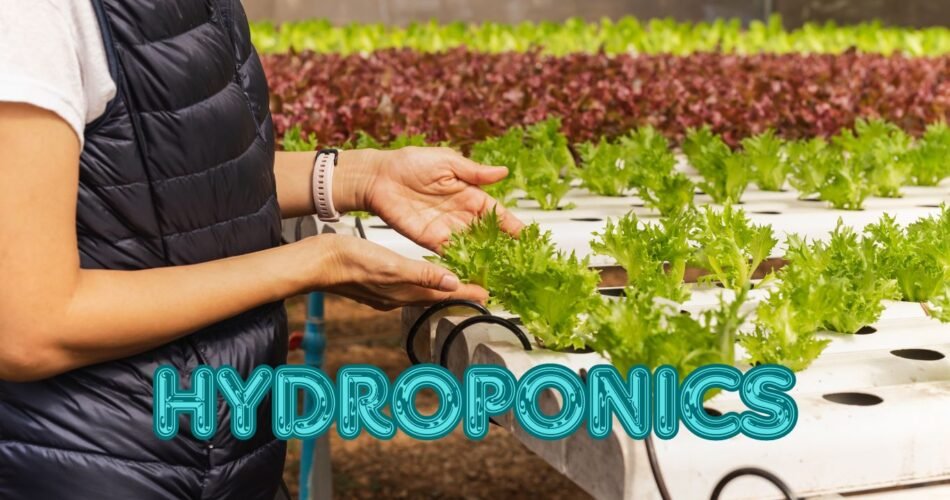This blog provides information about Hydroponic Technique. In the start, it explains what is hydroponics and introduction to hydroponics. Then it mentions some crops that are grown with hydroponics. It also explain the two Categories of Hydroponics. Then it elaborates the Types of Hydroponics in detail. It also contains Advantages and Disadvantages of Hydroponics. In the end it explains the difference between Aeroponics and Hydroponics and also explains if Hydroponics is Healthy. This blog contains Categories, Types, Advantages and Disadvantages of Hydroponics.
What is Hydroponics?
Hydroponics is the technique of growing plants using water-based nutrient solution rather than soil. It can include aggregate substrate or growing media for better performance. Hydroponics is a type of horticulture and also a subset of hydroculture that involves growing plants without soil and using water in place of soil.
Hydroponics show efficient growth of the plants. It is applicable to the areas where enough soil is not available to grow crops, food, medicinal plants and other essential crops. Many Physiologists and Plant Scientists use this technique from more than a century.
We can apply this technique at farms on large scale and also install in homes and kitchen gardens. The word Hydroponics comes from a Greek word, in which Hydro means “Water” and Ponos means “Labor”. It depicts that hydroponics use water as the labor to grow crops.
Hydroponic may in the liquid form or in aggregate form according to the requirement and resources so the detail about both of the Hydroponic techniques are in this blog. This blog contains information about Categories, Types, Advantages and Disadvantages of Hydroponics.
Crops from Hydroponics:
Following are some important crops that are from Hydroponic System:
Vegetables (Cucumber, Tomatoes, Lettuce, Pepper)
Ornamental Crops (Roses, Herbs, Freesia, Foliage plants)
Terrestrial and Aquatic Plants
Commercial Plants etc.
Categories of Hydroponic Systems:
There are two categories of Hydroponic systems. Either they are liquid or aggregate:
Liquid System:
It is the direct growth of crops in the liquid medium without interference of any artificial media. It provides greater control on water and on nutrient supply. This works by recirculating the nutrient solution Specific recipes are applied for leafy green and herbs as well as for fruiting crops. These systems are mostly in close forms.
Aggregate System:
In this system, a solid and inert medium is used in this type of hydroponic technique. This inert medium supports the plants to grow so as in the liquid system, we use liquid medium, in aggregate system the solid medium containing vermiculite, rockwool, sand, sawdust, peat etc. are as medium for plants to grow effectively. These systems are mostly open systems.
These are the two categories of Hydroponics.

Types of Hydroponics:
Following are the common types of Hydroponics:
1. Wick System:
The wick system is effectively the least complex sort of aquaculture framework that you can use to develop plants, and that implies that it tends to utilize by essentially anybody. The wick framework is eminent for not utilizing aerators, siphons, or power. As a matter of fact, the main tank-farming framework doesn’t need the utilization of power. With most of wick frameworks, the plants are settle straightforwardly inside a permeable substance like perlite or vermiculite.
2. Water Culture:
A water culture framework is one more profoundly oversimplified kind of tank-farming framework that puts the foundations of the plant straightforwardly into the supplement arrangement. While the wick framework puts specific materials between the plants and the water, the water culture framework sidesteps this obstruction. The oxygen that the plants need to endure is sent into the water by a diffuser or air stone.
3. Ebb and Flow:
The Ebb and Flow framework is one more famous aqua-farming framework that is principally utilize among home landscapers. With this sort of framework, the plants are situated in a roomy develop bed that is load with a develop medium like rockwool or perlite. When the plants are painstakingly planted, the develop bed will be overwhelmed with a supplement rich arrangement until the water arrives at a couple crawls underneath the top layer of the develop medium, which guarantees that the arrangement doesn’t spill over.
4. Drip System:
A drip system is a simple to-utilize tank-farming framework that can be immediately modify for various kinds of plants, which makes this an incredible framework for any cultivator who intends to roll out ordinary improvements. The supplement arrangement that is with a dribble framework is siphon into a cylinder that sends the arrangement directly to the plant base. Toward the finish of each cylinder is a trickle producer that controls how much arrangement is set into the plant.
5. Nutrient Film Technology:
he N.F.T system has a basic plan can utilize as a result of how well it scales to a wide range of utilizations. At the point when you utilize one of these frameworks. The supplement arrangement is into a huge repository. From here, the arrangement is siphon into inclined channels that permit the abundance supplements to stream once more into the repository. At the point when the supplement arrangement flows into the channel, it streams down the slant and over the foundations of each plant to give the perfect proportion of supplements.
6. Aeroponics:
A plant-cultivation technique in which the roots hang suspended in the air while nutrient solution is delivered to them in the form of fine mist. This technique does not require soil or an aggregate medium so in simple words it is the growth of plants by hanging roots and helped with spray of the nutrients. It needs some capital cost and maintenance throughout the time, but it will provide best quality food without the usage of soil. Aeroponics is an efficient process and it should be applied by every country who are in need of food or not so you can learn more about it in our blog Aeroponics.
These are the basic types of Hydroponics. This blog contains Categories, Types, Advantages and Disadvantages of Hydroponics.
Advantages of Hydroponics:
Following are the Advantages of Hydroponics:
It provide higher yield than soil.
This technique needs no soil to grow crops.
It requires less water that the soil.
There is less risk of weeds and also other invasive species.
It provides year-round food production.
Hydroponics is a sustainable technique of farming.
There is no risk of pesticides and chemicals in the crops.
The labor cost is much lower than the soil-based farming.
It provide space optimization and saves the space.
The nutrient control and water control is completely customizable.
These are the few advantages of Hydroponics.
Disadvantages of Hydroponics:
Following are the disadvantages of Hydroponics:
Plant diseases may occur in plants growing in this system.
Everyone need knowledge and experience before applying hydroponics.
As the medium is water, so waterborne diseases may occur in plants.
There is a faster growth of the crops.
It is more time-consuming to maintain and apply hydroponics.
There are threats of system failure in this system
Initial set-up or start-up cost is very high. Everyone cannot afford it
There can be imbalance of nutrients by human error.
It needs constant monitoring to avoid any malfunctioning.
Water and Electricity crisis may occur and also can waste your effort in a short time.
There is a need of High-skilled workers to apply hydroponics.
Aeroponics vs Hydroponics:
The difference between Aeroponics and Hydroponics is as follows:
1.In aeroponics roots of plants are suspended and nutrient mist is provided to it for growth.
In Hydroponics plants are submerge in the water all the time or fed by intermittent flow of water.
2.In aeroponics, the nutrients are sprayed on the roots of the plants.
In hydroponics, flow of water distribute nutrients or plants that grow in water containers.
3.Aeroponics derives from two Greek words ‘aero‘ means “air” and ‘ponos‘ means “work”.
Hydroponics is derives from Greek words ‘hydro‘ means “water” and ‘ponos‘ means “work”.
4.Aeroponics never grows in water.
Hydroponics always grows in water.
Is Hydroponics Healthy?
It is scientifically accepted that we can grow food crops in hydroponic technique without any worry. This technique shows up with the same nutrient-level of the crops as the soil-based crops. It is the technique that is sustainable as well as show effective growth of food crops. The results of this farming techniques are very good, as we can apply Hydroponics at large scales in the near future very easily so the only drawback is that, its initial cost is very high and very much know-how is the basic need for the organizers and workers for Hydroponics. This blog contains Categories, Types, Advantages and Disadvantages of Hydroponics.

To learn about more Topics, Click the links below:


Comments